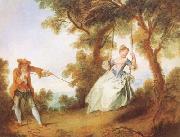Wholesale Oil Painting No Minimum |
|||||||||||
|
|
|||||||||||

|
|||||||||||
|
|
|
||||||||
Nicolas LancretFrench 1690-1743 Nicolas Lancret (22 January 1690 ?C 14 September 1743), French painter, was born in Paris, and became a brilliant depicter of light comedy which reflected the tastes and manners of French society under the regent Orleans. His first master was Pierre d'Ulin, but his acquaintance with and admiration for Watteau induced him to leave d'Ulin for Gillot, whose pupil Watteau had been. Two pictures painted by Lancret and exhibited on the Place Dauphine had a great success, which laid the foundation of his fortune, and, it is said, estranged Watteau, who had been complimented as their author. Lancret's work cannot now, however, be taken for that of Watteau, for both in drawing and in painting his touch, although intelligent, is dry, hard and wanting in that quality which distinguished his great model; these characteristics are due possibly in part to the fact that he had been for some time in training under an engraver. The number of his paintings (of which over eighty have been engraved) is immense; he executed a few portraits and attempted historical composition, but his favorite subjects were balls, fairs, village weddings, etc. The British Museum possesses an admirable series of studies by Lancret in red chalk, and the National Gallery, London, shows four paintings--the "Four Ages of Man" (engraved by Desplaces and l'Armessin), cited by d'Argenville amongst the principal works of Lancret. In 1719 he was received as Academician, and became councillor in 1735; in 1741 he married a grandchild of Boursault, author of Aesop at Court. |
||||||||
|
|
||||||||
The Swing (mk08)
The Swing (mk08) Painting ID:: 21882 |
Oil on canvas
70x89cm
London,Victoria and Albert Museum Oil on canvas 70x89cm London,Victoria and Albert Museum |
|||||||
|
|
||||||||
|
Jean Honore Fragonard 1732-1806 French Jean Honore Fragonard Locations French painter. He studied with François Boucher in Paris c. 1749. He subsequently won a Prix de Rome, and while in Italy (1756 ?C 61) he traveled extensively and executed many sketches of the countryside, especially the gardens at the Villa d Este at Tivoli, and developed a great admiration for the work of Giovanni Battista Tiepolo. In 1765 his large historical painting Coresus Sacrifices Himself to Save Callirhoë was purchased for Louis XV and won Fragonard election to the French Royal Academy. He soon abandoned this style to concentrate on landscapes in the manner of Jacob van Ruisdael, portraits, and the decorative, erotic outdoor party scenes for which he became famous (e.g., The Swing, c. 1766). The gentle hedonism of such party scenes epitomized the Rococo style. Although the greater part of his active life was passed during the Neoclassical period, he continued to paint in a Rococo idiom until shortly before the French Revolution, when he lost his patrons and livelihood. The Swing (mk08) 1767 Oil on canvas 81x65cm London,Wallace Collection |
||||||||
|
|
||||||||
|
Prev Next
|
||||||||
|
|
||||||||
|
Related Paintings to Jean Honore Fragonard :. |
||||||||
|
|
||||||||
|
CONTACT US |

